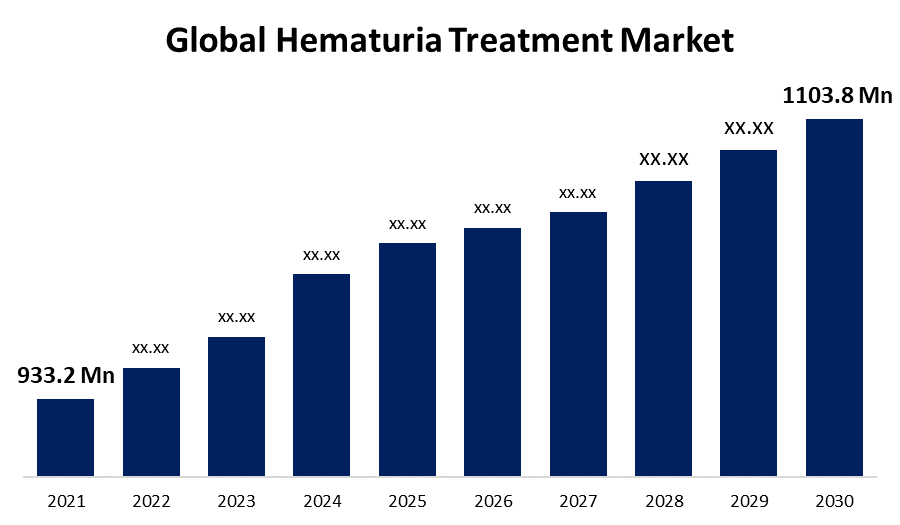Global Hematuria Treatment Market Size, Share, and COVID-19 Impact Analysis, By Type Outlook (Gross Hematuria, Microscopic Hematuria), By Indication (Urinary Tract Infection, Kidney Stones, Urethritis, Blood Cancer, Bladder Stones, Prostate Cancer, Cystitis, Trauma, Vigorous Exercise, Polycystic Kidney Disease, Endometriosis, and Menstruation), By End Users ( Hospitals, Clinics, and Others), By Region (North America, Europe, Asia-Pacific, Latin America, Middle East, and Africa), Analysis and Forecast 2021 - 2030
Industry: HealthcareGlobal Hematuria Treatment Market Insights Forecasts to 2030
- The Global Hematuria Treatment Market Size was valued at USD 933.2 million in 2021.
- The market is growing at a CAGR of 1.8% from 2022 to 2030.
- The Worldwide Hematuria Treatment Market size is expected to reach USD 1103.8 million by 2030.
- Asia Pacific is expected to grow the fastest during the forecast period.

Get more details on this report -
The Global Hematuria Treatment Market Size is expected to reach USD 1103.8 million by 2030, at a CAGR of 1.8% during the forecast period 2022 to 2030. The majority of people around the world are impacted by the prevalent and potentially fatal ailment known as chronic kidney disease (CKD). Renal stones, polycystic kidney disease, glomerulonephritis, and urinary tract infections are a few examples of the various CKDs. It is one of the main causes of hematuria and therefore drives the expansion of the hematuria treatment market.
Market Overview
Hematuria is a clinical term for blood in the urine. A kidney is a filtration unit that normally prevents blood from entering human urine. There are several causes for blood in the urine include, such as urinary tract infections, bladder or kidney stones, kidney infections (pyelonephritis), kidney disease, cancer, enlarged prostate, kidney injury, and kidney disease. Therefore, as a result, it's important to investigate the clinical reason for hematuria because, if left untreated, it could become a life-threatening condition. Even though blood in the urine is not always a sign of illness, it can be a crucial warning sign of a potential health problem. Depending on which portion of the tract is being treated, different antibiotics are recommended for treatment. However, the developments in the route of administration and different concentrations of drugs enable the prevention of the disease or infection to spread to cellular and molecular levels. According to the International Incontinence Society, 70% to 80% of adults over the age of 80 have symptoms of an overactive bladder. Age is a factor in the prevalence of hematuria, and people over the age of 35 are more likely to have its symptoms.
Report Coverage
This research report categorizes the global hematuria treatment market based on various segments and regions and forecasts revenue growth and analyses trends in each submarket. The report analyses the key growth drivers, opportunities, and challenges influencing the global hematuria treatment market. Recent market developments and competitive strategies such as expansion, product launch, and development, partnership, merger, and acquisition have been included to draw the competitive landscape in the market. The report strategically identifies and profiles the key market players and analyses their core competencies in each sub-segments of the global hematuria treatment market. Technological innovation and advancement will further optimize the performance of the product, enabling it to acquire a wider range of applications in the downstream market.
Global Hematuria Treatment Market Report Coverage
| Report Coverage | Details |
|---|---|
| Base Year: | 2021 |
| Market Size in 2021: | USD 933.2 Million |
| Forecast Period: | 2021-2030 |
| Forecast Period CAGR 2021-2030 : | 1.8% |
| 2030 Value Projection: | USD 1103.8 Million |
| Historical Data for: | 2017-2020 |
| No. of Pages: | 200 |
| Tables, Charts & Figures: | 105 |
| Segments covered: | By Type Outlook, By Indication, By End Users, By Region. |
| Companies covered:: | Pfizer, Inc., AstraZeneca plc, Novartis International AG., Johnson & Johnson, F. Hoffmann La Roche Ltd., Teva Pharmaceutical Industries Ltd., Boehringer Ingelheim GmbH, Cipla Ltd., Bristol Myers Squibb, GlaxoSmithKline, Inc., Merck & Co., Novartis International AG, Other prominent players |
Get more details on this report -
The major driving factor which may drive the market share growth is the growing frequency of chronic diseases has resulted in a significant increase in healthcare spending. Moreover, it is projected that the worldwide geriatric population would increase, driving up demand for hematuria treatments during the forecast period. The oral drugs are expected to boost the global market as most products are available in capsule and tablet form and it is a very feasible route of administration. Moreover, Governments from several different regions are investing heavily in improving healthcare infrastructure. Also, patients in developed economies are understanding more about the hematuria treatments that are available in the market.
Restraining Factors
The arrival of the pandemic followed by the decrease in the availability of medical professionals to offer hematuria treatment is likely to hamper the operations and the anticipated market growth that has been set for the forecast period. Also, the market expansion is certainly hampered by the high cost of the medications used to treat hematuria. Furthermore, the major market participants may face a significant challenge when a drug patent has expired. Moreover, the market for hematuria treatments revenue growth is restricted by undiscovered occurrences of related indications.
Market Segmentation
In 2021, the microscopic hematuria segment is dominating the market with the largest market share over the forecast period.
Based on the type outlook, the hematuria treatment market is bifurcated into gross hematuria and microscopic hematuria. Among these, microscopic hematuria dominated the market during the forecast period due to the rise in the number of patients suffering from microscopic hematuria. Rather than being discovered as a result of symptoms, microscopic hematuria is frequently found during routine testing.
In 2021, the urinary tract infection segment is leading the market over the forecast period.
Based on indication, the hematuria treatment market is bifurcated into urinary tract infection, kidney stones, urethritis, blood cancer, bladder stones, prostate cancer, cystitis, trauma, vigorous exercise, polycystic kidney disease, endometriosis, and menstruation. Among these, the urinary tract infection segment accounts for a major share of the hematuria market in the past decade, there has been an increase in UTI infections among women, which is the primary driver of market growth. A urinary tract infection affects the kidneys, bladder, urethra, and other parts of the urinary system.
In 2021, the hospital segment is dominating the market over the forecast period.
Based on the end users, the hematuria treatment is classified into hospitals, clinics, & others. Among these segments, the hospital segment held the largest market share due to many pharmaceutical companies implementing innovative technologies and cutting-edge treatments to address the public demands and requirements for the treatment of hematuria. Also, hematuria is caused due to the urinary tract infections medications such as antibiotics and therapy like shock wave therapy for treating the bladder or kidney stones and medications to shrink enlarged prostate gland are boosting the market growth of the hospital segment over the forecast period.
Regional Segment Analysis of the hematuria treatment market
- North America (U.S., Canada, Mexico)
- Europe (Germany, France, U.K., Italy, Spain, Rest of Europe)
- Asia-Pacific (China, Japan, India, Rest of APAC)
- South America (Brazil and the Rest of South America)
- The Middle East and Africa (UAE, South Africa, Rest of MEA)
North America is dominating the market with the largest market share during the forecast period

Get more details on this report -
North America accounts for the largest market share during the forecast period due to continuous development by businesses in the industry and the early adoption of cutting-edge medical technologies. Also, other factors like recent FDA approvals, favorable medical reimbursement policies, a large number of drugs in the pipeline, increasing focus on lowering the number of undiagnosed hematuria cases, and the accessibility of early treatment will propel the hematuria treatment market in the United States and Canada.
Europe is projected to be the second most appealing market for hematuria treatment due to an increase in demand for innovative therapeutics, extensive research in the treatment of urinary tract infections, and the geographical expansion of market players.
Competitive Analysis:
The report offers the appropriate analysis of the key organizations/companies involved within the hematuria treatment market along with a comparative evaluation primarily based on their product offering, business overviews, geographic presence, enterprise strategies, segment market share, and SWOT analysis. The report also provides an elaborative analysis focusing on the current news and developments of the companies, which includes product development, innovations, joint ventures, partnerships, mergers & acquisitions, strategic alliances, and others. This allows for the evaluation of the overall competition within the market.
List of Key Companies
- Pfizer, Inc.
- AstraZeneca plc
- Novartis International AG.
- Johnson & Johnson
- F. Hoffmann La Roche Ltd.
- Teva Pharmaceutical Industries Ltd.
- Boehringer Ingelheim GmbH
- Cipla Ltd.
- Bristol Myers Squibb
- GlaxoSmithKline, Inc.
- Merck & Co.
- Novartis International AG
- Other prominent players
Key Target Audience
- Market Players
- Investors
- End-users
- Government Authorities
- Consulting And Research Firm
- Venture capitalists
- Value-Added Resellers (VARs)
Recent Developments
- In April 2021, the FDA approved Farxiga (dapagliflozin) oral tablets to reduce the risk of renal function decline, kidney failure, cardiovascular mortality, and heart failure hospitalizations in people with chronic kidney disease who are susceptible to the disease progressing have chronic renal disorder.
- On June 2021, For the objective of developing antibody-drug conjugates, Bristol-Myers and Eisai Co. Ltd. signed a collaboration agreement.
- On September 2021, Merck announced the acquirement of Acceleron by purchasing the shares in tender and Acceleron is now become a subsidiary of Merck.
Market Segment
This study forecasts revenue at global, regional, and country levels from 2019 to 2030. Spherical Insights has segmented the Global Hematuria Treatment Market based on the below-mentioned segments:
Global Hematuria Treatment Market, By Type
- Gross Hematuria
- Microscopic Hematuria
Global Hematuria Treatment Market, By Indication
- Urinary tract infection
- Kidney stones
- Urethritis
- Blood cancer
- Bladder stones
- Prostate cancer
- Cystitis
- Trauma, vigorous exercise
- Polycystic kidney disease
- Endometriosis
- Menstruation
Global Hematuria Treatment Market, By End Users
- Hospitals
- Clinics
- Others
Hematuria Treatment Market, By Regional Analysis
- North America
- US
- Canada
- Mexico
- Europe
- Germany
- Uk
- France
- Italy
- Spain
- Russia
- Rest of Europe
- Asia Pacific
- China
- Japan
- India
- South Korea
- Australia
- Rest of Asia Pacific
- South America
- Brazil
- Argentina
- Rest of South America
- Middle East & Africa
- UAE
- Saudi Arabia
- Qatar
- South Africa
- Rest of Middle East & Africa.
Need help to buy this report?